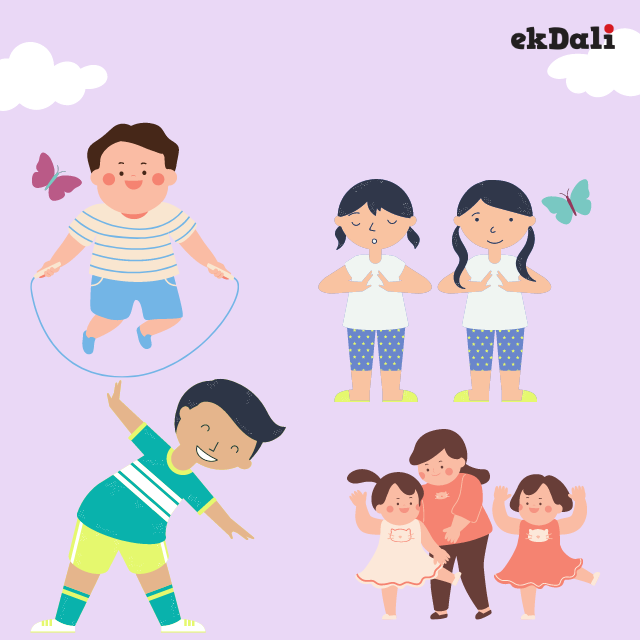Did you know that only approximately one-fourth of youngsters get the necessary 60 minutes of physical activity per day?
Participation in all sorts of physical activity decreases considerably as a child's age and grade level grow. Physical activity should be a frequent element of family life. Here's some advice to help you keep your kids healthy and active.
The Advantages of Physical Activity
Being physically active entails moving sufficiently to cause heavy breathing, shortness of breath, warmth, and sweating. Children's health and well-being benefit greatly from physical activity. For example, physical activity contributes to the development and maintenance of healthy bones, muscles, and joints. It can help maintain a healthy body mass index and lower your chances of diabetes, high blood pressure, and heart disease later in life. It can help children fall asleep faster and sleep better.
Physical activity not only benefits the body but also improves a child's mental and behavioral health. It enhances a child's enthusiasm and optimism while also improving self-esteem, academic achievement, attention, and behavior. It also lowers anxiety, stress, and despair. When used in conjunction with an organized sport, it can help build collaboration and friendship.
11 Ways to Get Started
Parents can play an important role in helping their children become more physically active. A few suggestions:
1. Speak with your child's doctor. Your child's doctor can explain why physical activity is crucial. Your child's doctor can also assist you and your child in determining which sports or activities are most appropriate for your youngster.
2. Prioritize fun. Help your youngster discover a sport she enjoys. The more she appreciates the action, the more likely she is to continue doing it. Get the whole family engaged. It's an excellent way to spend time together.
3. Select an activity that is developmentally suitable. For example, a 7- or 8-year-old child is not ready for weightlifting or a 3-mile run, but soccer, bicycle riding, and swimming are all excellent sports for children of this age.
4. Plan ahead. Make sure your youngster has a convenient time and location for exercise.
5. Create a safe environment. Make sure your child's equipment and the area where they practice or play are safe. Make sure your youngster is dressed comfortably and appropriately for the activity.
6. Provide active toys. Young children want easy access to balls, jump ropes, and other energetic toys.
7. Be a role model. Children who witness their parents participating in sports and physical activity on a regular basis are more likely to follow suit.
8. Play with your kids. Help them learn a new sport or physical activity. Or simply have fun together by going on a stroll, hike, or bike ride.
9. Set limits. Limit your daily screen time, including TV, videos, laptops, and video games. Use your free time to engage in additional physical activity.
10. Make time to workout. Some youngsters are so busy with homework, music lessons, and other organized activities that they don't have time to exercise.
11. Do not overdo the activities. Exercise and physical activity should not cause harm. If it gets painful, your child should slow down or switch to a less strenuous activity. As with any activity, it is critical not to overdo it. If exercise begins to interfere with school or other activities, consult your child's doctor.
Healthy, active lifestyle
During well-child checkups (also known as health monitoring visits), your child's doctor will ask you about nutrition, fitness, and media habits. Remember that health is not defined by a specific weight, shape, or size. All children, regardless of weight, shape, or size, are encouraged to lead healthy and active lifestyles.
To live a healthy, active life, families might seek to achieve the following goals:
- Consume at least five servings of fruits and vegetables daily.
- Create a Family Media Use Plan to balance both online and offline activities.
- For children and adolescents aged 6 and up, it is recommended to engage in at least 60 minutes of daily physical activity and a couple days per week of bone and muscle strengthening exercises. Children under the age of six require at least three hours of physical activity per day. Get at least an hour of moderate to strenuous physical activity per day.
- Avoid sugary beverages. For healthy hydration, choose either water or milk.
Get the entire family moving.
According to research, habits learned in childhood are considerably more likely to persist into maturity. If sports and physical activities are prioritized in the family, they will lay a solid basis for children's and parents' long-term health.
We make educational posters, flash cards and maps for kids. These are designed to help kids learn better. From our store we recommend you buy world map for wall. It is a great resource to teach kids about our world.
























